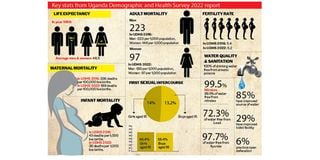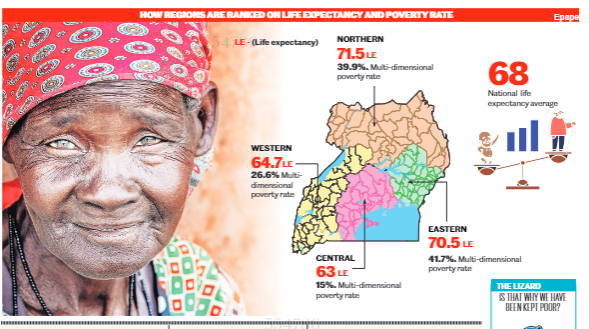Prime
Ugandans living longer, health survey indicates

What you need to know:
- The increase in life expectancy was, however, more notable in females.
- In men, it rose from 46 in 1969 to 65 in 2022, while for women, it increased from 47 to 68.9 within the same period.
New figures unveiled by the government on Thursday show that Uganda’s life expectancy shot up by 17 years across the past two decades.
The increment in average longevity of a Ugandan from 50 years to 68 years from 2002 to 2022, government statistics show, by far eclipses what was managed between 1969 and 2002.
During that aforesaid period, life expectancy only increased by around four years—from 46.5 years to 50.4 years.
This information is contained in the Uganda Demographic and Health Survey (UDHS) main report 2022. The report was released by the Uganda Bureau of Statistics (UBOS) on Thursday in Kampala.
Experts and politicians have linked this rise in life span to improved access to healthcare and social services following increased government investment.
“There have been several interventions that have contributed to increased life expectancy. We have antenatal care, and increased ownership of mosquito nets [for malaria prevention]. There has also been a reduced burden of diseases like malaria and HIV/Aids, and nutrition and food security have also improved,” Prof Robert Wamala, the deputy director for research and innovation at Makerere University, told Sunday Monitor.
He added: “There were also improvements in socio-economic status and infrastructure, which in a way contributed to reducing mortality and improving health and wellbeing of the population. I am looking at Uganda slowly transiting from just being a young [nation], so that means we should begin to plan for older persons.”
Mortality rate
According to the new UDHS 2022 report, infant mortality has decreased by half from 71 deaths per 1,000 live births in 2006 to 36 live births in 2022. The report also shows that under-five mortality reduced markedly from 128 to 52 per 1,000 live births during the same period.
As for maternal deaths, the numbers have also reduced from 336 deaths per 100,000 live births in 2016 to 189 deaths per 100,000 live births in 2022.
“The decline in death means the government is working,” Mr Amos Lugoloobi, the state minister for Planning at the Finance ministry, said. ”It shows that our investment in the health sector, education, food, and nutrition, is working.”
Mr Lugoloobi also said the key findings would be discussed in the Cabinet to ensure the gains are sustained and more improvement is made.
The increase in life expectancy was, however, more notable in females. In men, it rose from 46 in 1969 to 65 in 2022, while for women, it increased from 47 to 68.9 within the same period.
Dr Patrick Tusiime, a public health expert and Ministry of Health’s commissioner of communicable diseases prevention and control, said men are more likely to die younger. This, he added, is because of poor health-seeking behaviour, risky lifestyles, and poor stress management.
“More men are drowning in alcoholism and other drug addictions than women. It is also easier to catch a man in bad driving, theft, and other crimes than it is to find women,” he said.
Teenage pregnancy
The report also shows that teenage pregnancy remains high at 24 percent, with only a one percent decline from 25 percent in 2016, despite increased investment in the fight.
Related to this, at least 13 percent of young people aged 15 had already had their first sexual intercourse amid government policies that limit access to some reproductive health services for young people.
About 60 percent of young people aged 18 also said they already had their first sexual intercourse in a country that is predominantly religious (Christian and Islam) and abstinence from sex is strongly encouraged for those not married. Median age at first marriage is around 19 for girls and 25 for boys.
Dr Betty Kyaddondo, the director of family health at the National Population Council, said the report speaks a lot on how the country is investing in the quality of life of the population.
“We can celebrate because some of the indicators are improving, but there are indicators that are not faring so well—such as fertility. Our population is predominantly young. Whereas Prof Wmala is saying we should start thinking about the aging population, we are relatively still a very young nation,” she said, adding: “Seventy percent of the population of Uganda is below 35 years. This can be very beneficial to us if we invest in these young people so that they can be part of a drive for human capital growth. But this will not happen when some children are not going to school.
“What is happening to the four percent of boys and nine percent of the girls who are not in school? Where are they? Forty-one percent of youth aged between 18 and 30 years are not in school and are not in employment. But if we are to improve the economy, we need to address this. As we review our policy. Our UPE [Universal Primary Education] and USE [Universal Secondary Education] policies promote free education but why is it that our children are not going to school?” she added.
Dr Kyaddondo also said there is a need to empower teenage girls and allow them to go back to school.
“We need to see girls growing up to be girls and not girls growing up to be mothers. If girls were not giving birth at a very early age, probably maternal mortality would not be very high at 189 [per 100,000] live births,” she said.
“These girls would also be in school and contribute to the national development more. We also need to address the non-communicable diseases. The prevalence might be low, but they have a very high impact on socio-economic development. We need to use this data to inform our policies and we should also implement our policies,” she added.
Multi-sectoral approach
Dr Jane Ruth Aceng, the Health minister, said the findings show the impact of the government’s interventions over time.
“They also help us in supporting policies and formulating policies that work. Since 2020, that is the beginning of NDPIII [National Development Plan], we have been waiting to know the health status of the population based on the independent population-based survey,” she said.
Minister Aceng also hailed the “tremendous progress” made in maternal and child health. Conversely, she conceded to the scorecard on nutrition, as well as malaria and HIV not looking good.
“We need to embrace a multi-sectoral approach to address these gaps. There is also information on the refugee population. We should keep track of their health status because they live with us. We should also address gaps in early childhood development and water quality,” she offered.
Malaria burden
The Uganda Demographic and Health Survey (UDHS) report also captures many health indicators such as ownership of at least one insecticide-treated mosquito net per household, which has increased from 78 percent in 2016 to 100 percent in 2022, signalling more opportunity to prevent malaria. Figures on the use of mosquito nets were, however, not provided in the report which this reporter saw.
The country has in the last two years been struggling with an upsurge in malaria, with doctors reporting failure of common antimalarial drugs to cure patients amid other environmental drivers like heavy rainfall which increased mosquito breeding in many parts of the country.
Still in the report, the number of mothers seeking antennal care and delivering at health facilities has also increased. Up to 86 percent of women are now delivering in health facilities, an increase from 60 percent in 2011.




